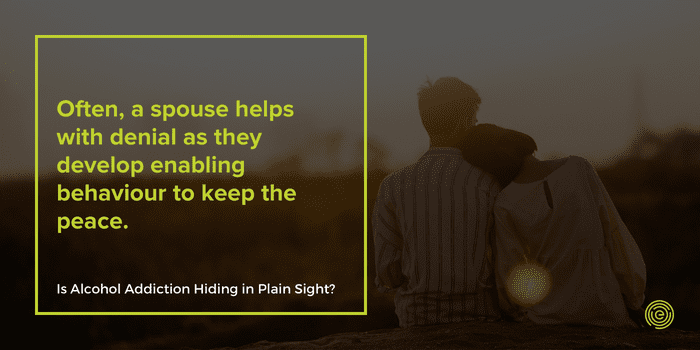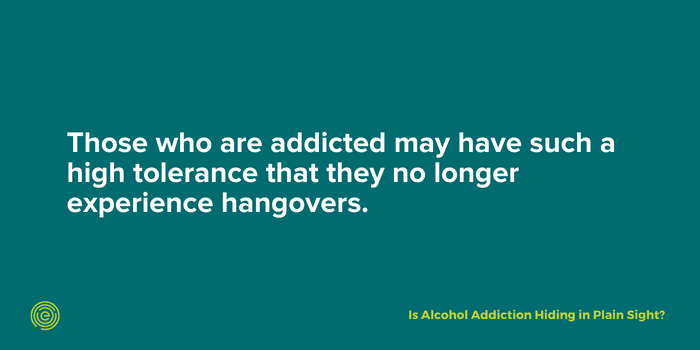Alcohol addiction hides in plain sight in both families and across all workplaces as those struggling learn how to hide their addiction. The signs of functioning alcoholism are there, but they may practice deceptive denial that masks other symptoms.
Understanding Alcohol Addiction
Living or working with someone who is struggling with addiction may begin to feel normal, particularly if they are the family’s primary income maker. They go to work every day, except for a few sick days, to bring home a steady paycheque. They understand their tolerance levels because they must go beyond the minimal “high” of intoxication and still “act” normal.
Unfortunately, co-workers and family members learn ways to overlook, minimize, and live with it. Keeping the peace at home is all too common. Often, a spouse helps with denial as they develop enabling behaviour to keep the peace.
How Does Alcohol Affect the Brain?
Alcohol is a toxic substance that damages vital organs like the liver. Short-term depressant effects and euphoria promote long-term psychoactive problems like addiction. While the emotional and psychological effects of short and long-term alcohol abuse are well known, alcohol’s effects on a drinker’s brain versus a non-drinker normal brain don’t get equal attention.
As a toxic substance, alcohol damages a human brain, especially a developing human brain. Alcohol abuse can cause brain shrinkage and result in smaller brain neurons. The short-term depressant effects come from alcohol blocking brain functions like balance, judgment, and speech. Cognitive impairment is common, as are symptoms like weight gain.

In extreme cases, people can blackout, a condition where alcohol blocks the transfer of short-term memory into places where the brain stores long-term memory in the hippocampus. The psychological effect of alcohol consumption feels heavy to people because it causes the pancreas to make more insulin and makes people feel sluggish because it doesn’t get used.
High Alcohol Tolerance
One of the most striking pieces of information to come from Canada’s Low-Risk Alcohol Drinking Guidelines (LRDGT) is the warning that even small amounts of alcohol can be damaging. Even people with a high tolerance level don’t escape things like an increased risk of developing many types of cancer. Only when alcohol consumption levels go down does the risk of cancer decrease. Contrary to popular belief, the tolerance level isn’t an indication of a successful drinker but a drinker that drinks so much that the body is intoxicated but still functions normally. Like any addiction, it takes more alcohol over time to reach the same intoxication levels. Those who are addicted may have such a high tolerance that they no longer experience hangovers.
Behaviours and Signs of Alcohol Addiction
One of the most prevalent behaviours of a person who may be struggling with alcohol addiction is hiding drinking from everyone. Because those who are addicted to alcohol may still do everything they should, they believe sneaking around and drinking in private keeps their drinking a secret. Sneaky behaviour and secrecy are just two of the many personality, emotional, and family traits common among people who are addicted to alcohol.
Alcohol becomes the main focus of their lives. In short, they don’t feel “normal” without a drink. They won’t go places where there isn’t drinking involved or they will drink secretly in places they shouldn’t drink. Dishonesty is a tool for deception that they readily apply to get more alcohol. Priorities shift to focus on drinking as the tolerance levels increase.

Shame and guilt are big parts of the thinking of a person who is addicted to alcohol, believing that drinking in private dulls the feelings. When drinking at times when alcohol is appropriate, they are prone to reckless behaviour and over-the-top actions, often causing disturbances or partaking in risky behaviour.
Health Risks of Excessive Drinking
Excessive alcohol consumption carries significant health risks across all aspects of a person’s well-being. Chemically, alcohol is a toxic substance the body must work hard to eliminate. Higher-proof liquor means more alcohol content. Alcohol can poison a person.
Consequently, long-term heavy drinking keeps the blood alcohol level high enough that the body can’t get rid of it, leading to an increased risk of developing liver diseases. Conversely, long-term moderate alcohol consumption can cause specific types of kidney failure. Combined with aging and illnesses already prevalent in older adults and alcohol’s long-term negative health problems worsen.
How can you help someone who is struggling?
In 2019, the Canadian Alcohol and Drug Survey (CADS) reported that 76% of Canadians consumed an alcoholic beverage in the previous year. Of those respondents, 21% reported having at least one of the five harms identified on the CADS, including being unable to stop drinking once started; failing to do what was normally expected from you because of drinking; needing a first drink in the morning to get yourself going after a heavy drinking session; being unable to remember what happened the night before because of your drinking; or having a feeling of guilt or remorse after drinking.
The 2019 edition of CADS was the first time quantified harms were included in the research, which is important because alcohol consumption disorders influence family members and drinkers.
Alcohol abuse leads to a broader list of alcohol-related harms that worry friends and family members. Some options help family members deal with an ultimatum – go to rehab or else! Known clinically as an intervention, family, and friends gather in a planned event to confront the addict in a surprise meeting. Each group member tells the addict how they feel and what they expect and pleads with the addict to get help. The implication is that collectively the group ostracizes the addict if they don’t go to rehab. The goal is to self-initiate a plea for help, usually in an inpatient rehab facility.
The Danger of Alcohol Withdrawal
Alcohol is unique in that it’s the only psychoactive addictive substance not globally controlled by some type of legal framework. This leads to unregulated and unrestricted widespread use of alcohol and alcohol use disorders. Unfortunately, alcohol withdrawal symptoms can cause pain and be dangerous, especially to a long-term drinker that immediately stops drinking.
Sudden abstinence isn’t recommended because withdrawal symptoms might be medically dangerous. Alcohol withdrawal goes beyond experiencing a feeling of discomfort and can cause delirium tremens (DTs), characterized by confusion and hallucinations. Although rare, DTs can result in seizures and death. Other common withdrawal symptoms include foggy thinking, anxiety, and agitation.
Medical treatment under a doctor’s care is the recommended path to mitigate any potential health problems when quitting alcohol. Detox in a certified medical rehab center offers the best way to recognize triggers that lead to using alcohol.
Seeking Treatment
Alcohol addiction treatment in a medically certified treatment centre is the best option. A drug and alcohol rehab program with medically monitored detox improves a person’s chances of success. Depending on the severity, the patient may need inpatient residential care and recovery before moving on to outpatient care.
Simply “dealing with” a person who is struggling isn’t worth the risk to personal, financial, and family safety. The solution often is treatment in a rehab facility specializing in programs for addicts that includes family therapy. If you or a loved one is in need of help, an EHN Canada program for alcohol addiction treatment may be the answer. Begin by filling out our Admissions form or by calling 1-866-963-6343.



